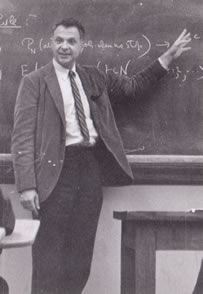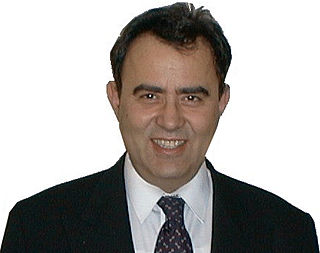Related Research Articles
Operations research, often shortened to the initialism OR, is a discipline that deals with the development and application of analytical methods to improve decision-making. The term management science is occasionally used as a synonym.

In probability theory and related fields, a stochastic or random process is a mathematical object usually defined as a sequence of random variables, where the index of the sequence has the interpretation of time. Stochastic processes are widely used as mathematical models of systems and phenomena that appear to vary in a random manner. Examples include the growth of a bacterial population, an electrical current fluctuating due to thermal noise, or the movement of a gas molecule. Stochastic processes have applications in many disciplines such as biology, chemistry, ecology, neuroscience, physics, image processing, signal processing, control theory, information theory, computer science, and telecommunications. Furthermore, seemingly random changes in financial markets have motivated the extensive use of stochastic processes in finance.

Decision theory is a branch of applied probability theory and analytic philosophy concerned with the theory of making decisions based on assigning probabilities to various factors and assigning numerical consequences to the outcome.

Herbert Ellis Robbins was an American mathematician and statistician. He did research in topology, measure theory, statistics, and a variety of other fields.
Decision analysis (DA) is the discipline comprising the philosophy, methodology, and professional practice necessary to address important decisions in a formal manner. Decision analysis includes many procedures, methods, and tools for identifying, clearly representing, and formally assessing important aspects of a decision; for prescribing a recommended course of action by applying the maximum expected-utility axiom to a well-formed representation of the decision; and for translating the formal representation of a decision and its corresponding recommendation into insight for the decision maker, and other corporate and non-corporate stakeholders.

In the design of experiments, optimal designs are a class of experimental designs that are optimal with respect to some statistical criterion. The creation of this field of statistics has been credited to Danish statistician Kirstine Smith.
Peter Whittle was a mathematician and statistician from New Zealand, working in the fields of stochastic nets, optimal control, time series analysis, stochastic optimisation and stochastic dynamics. From 1967 to 1994, he was the Churchill Professor of Mathematics for Operational Research at the University of Cambridge.

In probability theory and machine learning, the multi-armed bandit problem is a problem in which a fixed limited set of resources must be allocated between competing (alternative) choices in a way that maximizes their expected gain, when each choice's properties are only partially known at the time of allocation, and may become better understood as time passes or by allocating resources to the choice. This is a classic reinforcement learning problem that exemplifies the exploration–exploitation tradeoff dilemma. The name comes from imagining a gambler at a row of slot machines, who has to decide which machines to play, how many times to play each machine and in which order to play them, and whether to continue with the current machine or try a different machine. The multi-armed bandit problem also falls into the broad category of stochastic scheduling.
The Gittins index is a measure of the reward that can be achieved through a given stochastic process with certain properties, namely: the process has an ultimate termination state and evolves with an option, at each intermediate state, of terminating. Upon terminating at a given state, the reward achieved is the sum of the probabilistic expected rewards associated with every state from the actual terminating state to the ultimate terminal state, inclusive. The index is a real scalar.
Lajos Takács was a Hungarian mathematician, known for his contributions to probability theory and in particular, queueing theory. He wrote over two hundred scientific papers and six books.
Statistics, in the modern sense of the word, began evolving in the 18th century in response to the novel needs of industrializing sovereign states.
Richard Robert Weber is a mathematician working in operational research. He is Emeritus Churchill Professor of Mathematics for Operational Research in the Statistical Laboratory, University of Cambridge.

Erik Gustav Elfving was a Finnish mathematician and statistician. He wrote pioneering works in mathematical statistics, especially on the design of experiments.
In queueing theory, a discipline within the mathematical theory of probability, an M/G/1 queue is a queue model where arrivals are Markovian, service times have a General distribution and there is a single server. The model name is written in Kendall's notation, and is an extension of the M/M/1 queue, where service times must be exponentially distributed. The classic application of the M/G/1 queue is to model performance of a fixed head hard disk.

Mathematical finance, also known as quantitative finance and financial mathematics, is a field of applied mathematics, concerned with mathematical modeling of financial markets.

Michael N. Katehakis is a Professor of Management Science at Rutgers University. He is noted for his work in Markov decision process, Gittins index, the multi-armed bandit, Markov chains and other related fields.

Cyrus Derman was an American mathematician and amateur musician who did research in Markov decision process, stochastic processes, operations research, statistics and a variety of other fields.
Stochastic scheduling concerns scheduling problems involving random attributes, such as random processing times, random due dates, random weights, and stochastic machine breakdowns. Major applications arise in manufacturing systems, computer systems, communication systems, logistics and transportation, and machine learning, among others.

Dirk Pieter Kroese is a Dutch-Australian mathematician and statistician, and Professor at the University of Queensland. He is known for several contributions to applied probability, kernel density estimation, Monte Carlo methods and rare event simulation. He is, with Reuven Rubinstein, a pioneer of the Cross-Entropy (CE) method.
Stephen Mitchell Samuels was a statistician and mathematician, known for his work on the secretary problem and for the Samuels Conjecture involving a Chebyshev-type inequality for sums of independent, non-negative random variables.
References
- ↑ Whittle, Peter (1980). "Multi-armed bandits and the Gittins index". Journal of the Royal Statistical Society, Series B. 42 (2): 143–149. JSTOR 2984953.
- ↑ Whittle, Peter (2002). "Applied probability in Great Britain (50th anniversary issue of Operations Research)". Oper. Res. 50 (1): 227–239. doi: 10.1287/opre.50.1.227.17792 . JSTOR 3088474.